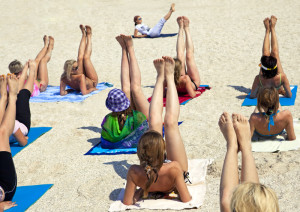You have probably seen hundreds of TV commercials advertising the latest abdominal exercisers, diet pills, and workout videos promising to shred your belly fat and leave you with sexy, six-pack abs.
Well, be warned before you go forking out a great big handful of hard earned cash. What they don’t want you to know is that no specific type of workout, combination of exercises, or revolutionary diet compound will give you visible abs if you don’t also eat properly. Abs and belly fat loss start in the kitchen and you are in full control.

Now settle in for some eye-opening facts about beer bellies and muffin tops.
When your goal is loss of belly fat, the most important thing you can do to reach that goal is follow a good nutrition program. Exercise and everything else comes second.
While diet books and gurus constantly argue about the best diet to follow for fat loss, a nugget of truth remains after the rest is stripped away: for most people, fat loss happens when their diets are mostly composed of protein and fibrous vegetables.
Chicken or turkey breasts, lean grass fed beef, kangaroo, oily fish (salmon) or eggs, combined with broccoli, cauliflower, kale, spinach, asparagus, and other nutritious, fiber-filled veggies should form the backbone of meals.
The dense nutrition will keep you full for longer, decreasing your overall calories eaten.
Some debate about appropriate carbohydrate levels still rages, but again, one rule of thumb has emerged from the chaos.
If you exercise intensely several times a week, your body requires more carbohydrates than it does when you’re sedentary. For some people, this means the difference between losing fat at fifty grams of carbohydrates per day when sedentary or at a few hundred grams per day when following an intense exercise program.
You don’t need to keep filling the petrol tank if your car is sitting in the garage, but if you take it out and race it frequently, it’s going to need a lot more fuel.
Your body follows the same principle. Carbohydrates you do choose to consume should be from complex, nutritious sources such as fresh seasonal fruits, starchy veggies (sweet potatoes or kumera) and some whole grains such as Basmati brown rice, quinoa, chia seeds and farro (try this recipe from Jamie Oliver – farro salad with roasted veg – I am sure it will become one of your favourite dishes).
Don’t forget to add some healthy fats like virgin olive oil, fish oils, avocados, nuts, and seeds (think Mediterranean diet), but don’t go so overboard that your calorie counts are too high. Fats of this nature are vital for good health, but they do contain a lot of calories and should be monitored. Snacking on a handful of almonds is great; sitting down and working your way through an entire packet of peanuts in one sitting is not.
Once the diet (or lifestyle change) is in place, strength training should be done at least two times per week to maintain lean body mass while the body is in a caloric deficit. Cardiovascular exercise in the form of steady-state cardio and/or interval training should also be added to speed up fat loss results and improve cardiovascular health.
Every person’s body works differently, and in every diet there will be variations based on personal taste and preferences. In general, following these principles will help the majority of people who have struggled to understand nutrition basics cut through the nonsense of the fad diet industry and finally settle on a plan that works for them.
To take us out for this article it is also worth considering Harvard Medical School’s take on “abdominal fat and what to do about it”. In their report they pose the following, “So what can we do about tubby tummies? A lot, it turns out.

The starting point for bringing weight under control, in general, and combating abdominal fat, in particular, is regular moderate-intensity physical activity — at least 30 minutes per day (and perhaps up to 60 minutes per day) to control weight. Strength training (exercising with weights) may also help fight abdominal fat. Spot exercising, such as doing sit-ups, can tighten abdominal muscles, but it won’t get at visceral fat. Diet is also important.”
As I said to someone the other day, “Abs start in the kitchen.” So personally, I recommend diet combined with portion control (or what I prefer to call lifestyle habits) in combination with a good exercise program are the all-important factors to rid yourself of belly fat.
And just before I go, if you are a guy with a waistline bigger than 38 inches, read on for some more alarming facts on how dangerous is a big belly.
Leave a Reply